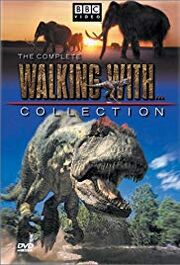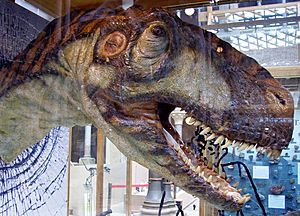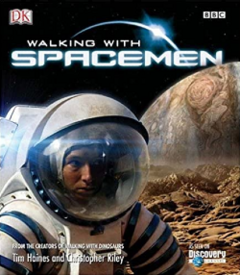Walking with... facts for kids
Quick facts for kids Walking with... |
|
|---|---|

Cover of the Australian 2008 DVD box set of the franchise
|
|
| Creator | Tim Haines & Jasper James |
| Original work | Walking with Dinosaurs |
| Owner | BBC |
| Print publications | |
| Books | See below |
| Films and television | |
| Television specials |
|
| Theatrical presentations | |
| Plays | Walking with Dinosaurs − The Arena Spectacular |
| Games | |
| Video games | See below |
The Walking with... series is a group of TV shows and other media created by the BBC Studios Science Unit. These shows bring ancient animals back to life using amazing computer graphics and puppets. They are made to look like real nature documentaries, showing how these creatures might have lived millions of years ago.
The first show, Walking with Dinosaurs (1999), was a huge hit. It led to more series like Walking with Beasts (2001), Walking with Cavemen (2003), Sea Monsters (2003), and Walking with Monsters (2005). People loved the special effects and how the shows taught them about science. Scientists generally praised the series for trying to be accurate and showing prehistoric life as real animals, not just scary monsters.
Besides the main TV shows, the Walking with... world also includes special episodes like The Ballad of Big Al, The Giant Claw, and Land of Giants. There are also books, video games, and even a live stage show called Walking with Dinosaurs − The Arena Spectacular. In 2013, a movie based on Walking with Dinosaurs was released.
Contents
How the Walking with... Series Began
The idea for Walking with Dinosaurs came from Tim Haines, a science TV producer at the BBC, in 1996. He was inspired by the movie Jurassic Park (1993). Haines wanted to make a science-based show that used similar special effects to make dinosaurs look real.
At first, people worried the show would be too expensive. But Haines worked with a company called Framestore to keep costs down. After making a short test episode in 1997, he got funding from the BBC, BBC Worldwide, the Discovery Channel, and other international partners. Walking with Dinosaurs cost about £6.1 million (around $9.9 million) to make. This made it one of the most expensive documentaries ever per minute!
The amazing visual effects were created by Framestore. The realistic puppets and animatronics (moving models) were made by Crawley Creatures.
Expanding the Walking with... World
Because Walking with Dinosaurs was so successful, it quickly became a popular brand of documentary series. Tim Haines then started a production company called Impossible Pictures with Jasper James, who also worked on Walking with Dinosaurs.
In 2000, a special episode called The Ballad of Big Al was released. It focused on the life story of a single Allosaurus dinosaur. Then, in 2001, the first full sequel series, Walking with Beasts, came out. This show explored the animals that lived after the dinosaurs, in the Cenozoic era. Tim Haines wanted to introduce people to these less famous, but still amazing, ancient mammals.
Making Walking with Beasts was even harder than Dinosaurs for the special effects teams. Mammals have fur, whiskers, and other soft parts that are tricky to animate. Also, people are more familiar with how mammals move, so any mistakes would be easier to spot.
In 2002 and 2003, two more Dinosaurs specials were shown: Land of Giants and The Giant Claw. These shows featured wildlife presenter Nigel Marven as a "time-traveling zoologist." His role helped viewers understand how huge these ancient animals were.
While Haines and Impossible Pictures worked on these specials, the BBC made another series without them: Walking with Cavemen (2003). This show was a sequel to Beasts and explored human evolution. It was presented by Robert Winston. The success of Marven's specials led to Sea Monsters (2003), a mini-series where he explored the "seven deadliest seas of all time."
A series called Space Odyssey (2004) was originally going to be named Walking with Spacemen. It used the same special effects from the Walking with... shows to imagine how astronauts might explore other planets. Even though the name changed, some books and materials still used the old title.
Finally, Haines and Impossible Pictures decided to finish the Walking with... series by exploring an even older time: the Paleozoic era, which was before the dinosaurs. Walking with Monsters (2005) used the most advanced effects of all the shows, thanks to new technology.
Framestore and Crawley Creatures worked on the computer graphics and animatronics for almost all the series. After Monsters, the companies involved started making other types of shows, like Primeval, because it became harder to get funding for documentaries about prehistoric life.
Walking with... TV Shows
These are the main TV series in the Walking with... collection:
| Series | Release date (UK) | Director(s) | Producer(s) | Episodes | Narrator (UK) | Composer |
|---|---|---|---|---|---|---|
| Walking with Dinosaurs | 4 October – 8 November 1999 | Tim Haines & Jasper James | John Lynch, Tim Haines & Jasper James | 6 | Kenneth Branagh | Ben Bartlett |
| Walking with Beasts | 15 November – 20 December 2001 | Jasper James & Nigel Paterson | Tim Haines, Jasper James & Nigel Paterson | 6 | ||
| Walking with Cavemen | 27 March – 23 April 2003 | Richard Dale | Richard Dale, Nick Green, Mark Hedgecoe & Peter Oxley | 4 | Robert Winston | Alan Parker |
| Sea Monsters | 9–23 November 2003 | Jasper James | Tim Haines, Adam Kemp & Jasper James | 3 | Karen Hayley | Ben Bartlett |
| Walking with Monsters | 5 November 2005 | Chloe Leland & Tim Haines | Tim Haines & Chloe Leland | 3 | Kenneth Branagh |
| 1999 | Walking with Dinosaurs |
|---|---|
| 2000 | The Ballad of Big Al |
| 2001 | Walking with Beasts |
| 2002 | The Giant Claw |
| 2003 | Land of Giants |
| Walking with Cavemen | |
| Sea Monsters | |
| 2004 | |
| 2005 | Walking with Monsters |
Walking with Dinosaurs (1999)
This first series was designed to be like a "Natural History of Dinosaurs." It showed what life was like in the Mesozoic era, focusing on dinosaurs, as if it were a real nature documentary.
Special Episodes (2000–2003)
The Ballad of Big Al (2000) was the first special. It told the life story of a single Allosaurus dinosaur, based on a real fossil nicknamed ""Big Al"". Later specials, The Giant Claw (2002) and Land of Giants (2003), featured Nigel Marven as a "time-traveling zoologist" who went back in time to meet prehistoric creatures.
Walking with Beasts (2001)
Following Walking with Dinosaurs, Walking with Beasts explored prehistoric life in the same nature documentary style. This series focused on the Cenozoic era, showing how mammals became the main animals on Earth. It also touched on human evolution, with episodes featuring early human ancestors.
Walking with Cavemen (2003)
Walking with Cavemen continued the documentary style, but this time with presenter Robert Winston. It told the story of human evolution, from early ancestors like Australopithecus afarensis to modern humans. The show often focused on specific characters to make the story easier to follow.
Sea Monsters (2003)
In Sea Monsters, Nigel Marven returned as the "time-traveling zoologist." He traveled to seven different periods in prehistory, exploring the "seven deadliest seas of all time." He met and interacted with the amazing prehistoric creatures that lived in these ancient oceans.
Walking with Monsters (2005)
This series acts as a prequel to Walking with Dinosaurs. Walking with Monsters explores the ancient life of the Paleozoic era, which was even before the dinosaurs. The show highlights the constant struggle for survival, telling stories of individual animals in a long "war" between different animal groups for control.
Prehistoric Planet
Prehistoric Planet was a new version of Walking with Dinosaurs and Walking with Beasts. It was made by the Discovery Channel and NBC for the Discovery Kids network in 2002–2003. While most of the original animation stayed the same, new text was written for a younger audience. It was narrated by Ben Stiller (Season 1) and Christian Slater (Season 2). The show also included quizzes during commercial breaks and new music.
Books About Walking with...
Many books have been released alongside the Walking with... TV shows.
Companion Books
The first four Walking with... series each had a companion book. These large, illustrated books explored the settings and science from each show in more detail. They were filled with scientific facts and stories, and had many pictures from the episodes. These companion books were very popular.
- Walking with Dinosaurs: A Natural History (1999), by Tim Haines
- Walking with Beasts: A Prehistoric Safari (2001), by Tim Haines
- Walking with Cavemen: Stand Eye-to-Eye with your Ancestors (2003), by John Lynch and Louise Barrett
- Sea Monsters: Prehistoric Predators of the Deep (2003), by Nigel Marven and Jasper James
Other Books
Walking with Monsters did not have its own companion book. Instead, in 2006, the book The Complete Guide to Prehistoric Life was released. This encyclopedia-style book featured images from all the Walking with... shows.
Many other books have also been released. For example, Walking with Dinosaurs had books like Walking with Dinosaurs: The Evidence and Walking with Dinosaurs: The Facts, which explained the science behind the series. There are also children's books, like an adaptation of The Ballad of Big Al called Allosaurus! The Life and Death of Big Al. Plus, there were 3D albums, sticker albums, and photo journals for both Walking with Dinosaurs and Walking with Beasts.
Walking with... on Computers and Games
Most of the Walking with... series had websites that went along with them. The first Walking with Dinosaurs website (1999) was very new for its time. It offered scientific information, facts, glossaries, and even games and puzzles. The websites for later series had similar content, combining science facts with fun games.
Besides the website games, there have also been full video games. The first was a free computer game called Dinosaur World, released in 2001. It was based on The Ballad of Big Al and let players find different animals and plants. Another game, Walking with Beasts: Operation Salvage (2001), was a top-down shooter where players traveled back in time to observe animals and fight enemies.
In 2013, a new Walking with Dinosaurs video game was released to go with the movie. This game used augmented reality, which means it mixed computer graphics with the real world around you.



